苏教牛津版英语四上《Unit 7 It’s late》教学设计10
- 格式:doc
- 大小:92.00 KB
- 文档页数:14
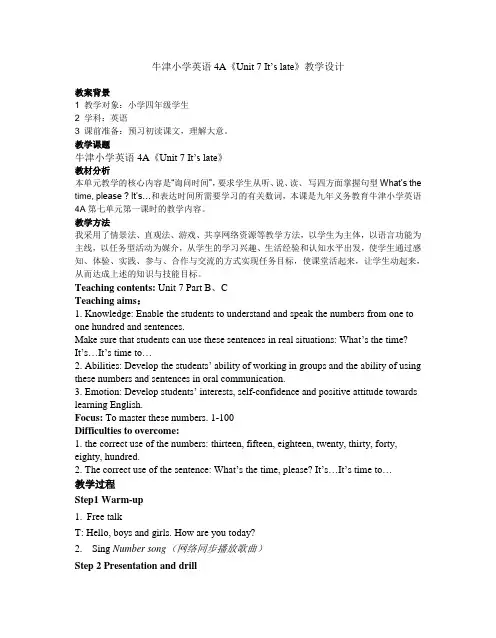
牛津小学英语4A《Unit 7 It’s late》教学设计教案背景1 教学对象:小学四年级学生2 学科:英语3 课前准备:预习初读课文,理解大意。
教学课题牛津小学英语4A《Unit 7 It’s late》教材分析本单元教学的核心内容是“询问时间”,要求学生从听、说、读、写四方面掌握句型What’s the time, please ? It’s…和表达时间所需要学习的有关数词,本课是九年义务教育牛津小学英语4A第七单元第一课时的教学内容。
教学方法我采用了情景法、直观法、游戏、共享网络资源等教学方法,以学生为主体,以语言功能为主线,以任务型活动为媒介,从学生的学习兴趣、生活经验和认知水平出发,使学生通过感知、体验、实践、参与、合作与交流的方式实现任务目标,使课堂活起来,让学生动起来,从而达成上述的知识与技能目标。
Teaching contents: Unit 7 Part B、CTeaching aims:1. Knowledge: Enable the students to understand and speak the numbers from one to one hundred and sentences.Make sure that students can use these sentences in real situations: What’s the time?I t’s…It’s time to…2. Abilities: Develop the students’ ability of working in groups and the ability of using these numbers and sentences in oral communication.3. Emotion: Develop students’ interests, self-confidence and positive attitude towards learning English.Focus: To master these numbers. 1-100Difficulties to overcome:1. the correct use of the numbers: thirteen, fifteen, eighteen, twenty, thirty, forty, eighty, hundred.2. The correct use of the sentence: What’s the time, please? I t’s…It’s time to…教学过程Step1 Warm-up1.Free talkT: Hello, boys and girls. How are you today?2.Sing Number song(网络同步播放歌曲)Step 2 Presentation and drill1、ReviewT: How many numbers can you see?Ss: I can see twenty numbers.T: What are they?Ss count from one to twelve together.T: What’s the next number?S: Thirteen.T (强调_teen的读音):_teen, _teen, thirteen.Let’s go on. Thirteen……Ss go on counting from 14 to 19T: From thirteen to nineteen, what can you find?Ss: 在有关的个位数词词尾加_teen .2.Teach twenty/thirty/forty/fifty/sixty/seventy/eighty/ninety Quick response(1) T: Game. Say the number after. TwelveSs: Thirteen.T: Nineteen.Ss: Twenty.(Write down Twenty)(2) T: What’s twenty plus ten?Ss: Thirty.(Write down Thirty)T: What’s twenty plus twenty?Ss: Forty.(Write down Forty)T: What’s twenty plus thi rty?Ss: Fifty.(3) T: What can you find? Try to spell 60, 70, 80, 90Ss: 在有关的个位数词词尾加-ty:sixty, seventy, eighty, ninety3. Teach 21-99(except 20, 30…90)T: Can you read these numbers? Try to read them!35 thirty-five 47 forty-seven 68 sixty-eight 99 ninet y-nineSs归纳其他十位数的构词规律。
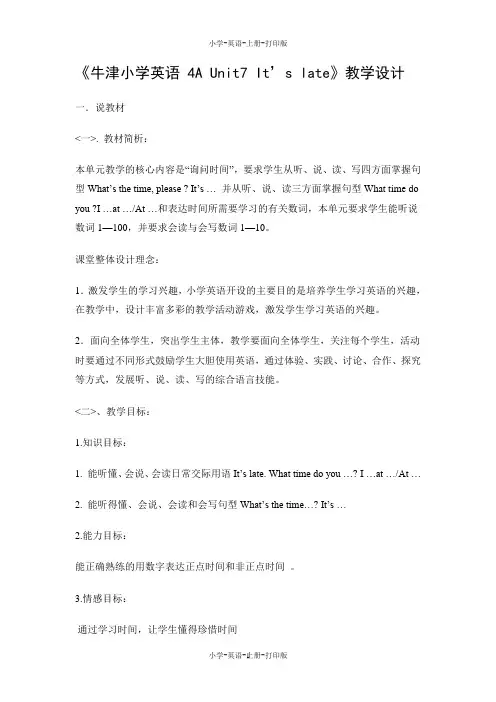
《牛津小学英语4A Unit7 It’s late》教学设计一.说教材<一>. 教材简析:本单元教学的核心内容是“询问时间”,要求学生从听、说、读、写四方面掌握句型What’s the time, please ? It’s … 并从听、说、读三方面掌握句型What time do you ?I …at …/At …和表达时间所需要学习的有关数词,本单元要求学生能听说数词1—100,并要求会读与会写数词1—10。
课堂整体设计理念:1.激发学生的学习兴趣,小学英语开设的主要目的是培养学生学习英语的兴趣,在教学中,设计丰富多彩的教学活动游戏,激发学生学习英语的兴趣。
2.面向全体学生,突出学生主体,教学要面向全体学生,关注每个学生,活动时要通过不同形式鼓励学生大胆使用英语,通过体验、实践、讨论、合作、探究等方式,发展听、说、读、写的综合语言技能。
<二>、教学目标:1.知识目标:1. 能听懂、会说、会读日常交际用语It’s late. What time do you …? I …at …/At …2. 能听得懂、会说、会读和会写句型What’s the time…? It’s …2.能力目标:能正确熟练的用数字表达正点时间和非正点时间。
3.情感目标:通过学习时间,让学生懂得珍惜时间<三>、教学重点:1. 能听懂、会说、会读日常交际用语It’s late. What time do you …? I …at …2. 能正确熟练的用数字表达正点时间和非正点时间。
<四>、教学难点:1. 能听懂、会说、会读日常交际用语It’s late. What time do you …? I …at …2. 能正确熟练的用数字表达正点时间和非正点时间。
<五>、教学准备:1.教学准备:多媒体课件2.学具准备:学生用书二、教学过程:Step 1. Warming up.1. Sing a song.《Ten little Indians》【设计意图】轻快熟悉的旋律,加上与上一课时相应的歌词,复习数字的同时,也是对这节课要学的内容的一个铺垫。
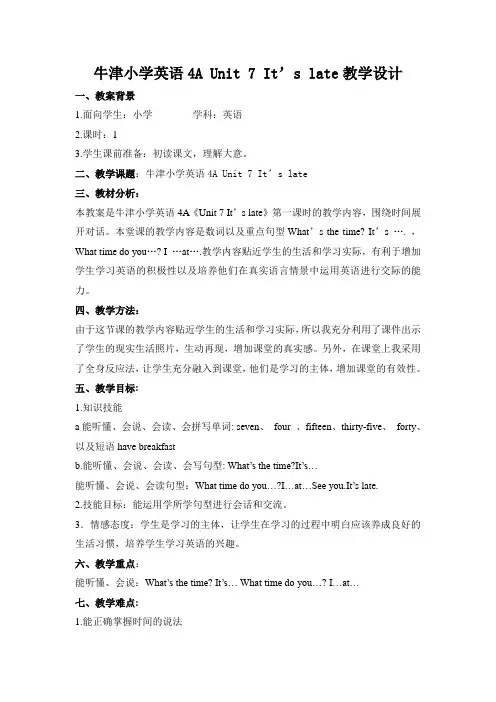
牛津小学英语4A Unit 7 It’s late教学设计一、教案背景1.面向学生:小学学科:英语2.课时:13.学生课前准备:初读课文,理解大意。
二、教学课题:牛津小学英语4A Unit 7 It’s late三、教材分析:本教案是牛津小学英语4A《Unit 7 It’s late》第一课时的教学内容,围绕时间展开对话。
本堂课的教学内容是数词以及重点句型What’s the time? It’s …. ,What time do you…? I …at….教学内容贴近学生的生活和学习实际,有利于增加学生学习英语的积极性以及培养他们在真实语言情景中运用英语进行交际的能力。
四、教学方法:由于这节课的教学内容贴近学生的生活和学习实际,所以我充分利用了课件出示了学生的现实生活照片,生动再现,增加课堂的真实感。
另外,在课堂上我采用了全身反应法,让学生充分融入到课堂,他们是学习的主体,增加课堂的有效性。
五、教学目标:1.知识技能a能听懂、会说、会读、会拼写单词: seven、four 、fifteen、thirty-five、forty、以及短语have breakfastb.能听懂、会说、会读、会写句型: What’s the time?It’s…能听懂、会说、会读句型:What time do you…?I…at…See you.It’s late.2.技能目标:能运用学所学句型进行会话和交流。
3.情感态度:学生是学习的主体,让学生在学习的过程中明白应该养成良好的生活习惯,培养学生学习英语的兴趣。
六、教学重点:能听懂、会说:What’s the time? It’s…What time do you…?I…at…七、教学难点:1.能正确掌握时间的说法2.能用所学句型进行简单的对话3.have breakfast的读音八、教具:课件九、教学过程:Step 1 Warm upT:Hello,boys and girls.S:Hello,Miss Wang.How are you?T:Fine,thank you.And you?S:I’m fine,too.T:Good!Today,I’m very happy,because we will learn a new lesson.Step 2 Presentation1、Sing a song:《Ten little Indians》设计意图:让学生在轻松愉悦的分为中学生英语,激发学生学习的热情。
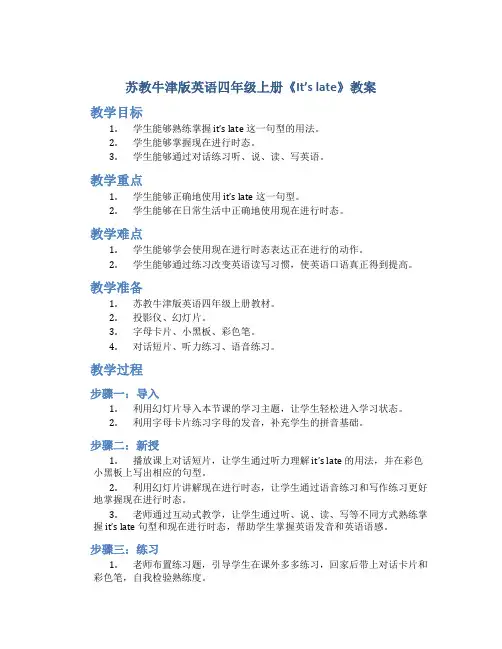
苏教牛津版英语四年级上册《It’s late》教案教学目标1.学生能够熟练掌握it’s late 这一句型的用法。
2.学生能够掌握现在进行时态。
3.学生能够通过对话练习听、说、读、写英语。
教学重点1.学生能够正确地使用it’s late 这一句型。
2.学生能够在日常生活中正确地使用现在进行时态。
教学难点1.学生能够学会使用现在进行时态表达正在进行的动作。
2.学生能够通过练习改变英语读写习惯,使英语口语真正得到提高。
教学准备1.苏教牛津版英语四年级上册教材。
2.投影仪、幻灯片。
3.字母卡片、小黑板、彩色笔。
4.对话短片、听力练习、语音练习。
教学过程步骤一:导入1.利用幻灯片导入本节课的学习主题,让学生轻松进入学习状态。
2.利用字母卡片练习字母的发音,补充学生的拼音基础。
步骤二:新授1.播放课上对话短片,让学生通过听力理解it’s late 的用法,并在彩色小黑板上写出相应的句型。
2.利用幻灯片讲解现在进行时态,让学生通过语音练习和写作练习更好地掌握现在进行时态。
3.老师通过互动式教学,让学生通过听、说、读、写等不同方式熟练掌握it’s late 句型和现在进行时态,帮助学生掌握英语发音和英语语感。
步骤三:练习1.老师布置练习题,引导学生在课外多多练习,回家后带上对话卡片和彩色笔,自我检验熟练度。
2.在教室里,通过互动式练习,老师和同学之间相互配合,帮助学生在真实的场景练习英语口语,增强对英语的敏感度和自信心。
步骤四:复习老师在课堂结束前,通过交流对学生上课的掌握情况进行一次简单回顾,帮助学生进行彻底复习。
总结在今天的教学中,通过幻灯片、互动式教学和口语练习等多种方式,学生能够熟练掌握it’s late 句型和现在进行时态,并通过练习提升英语口语能力。
对于英语学习,我们要不断总结经验,分享优质课堂资源,不断创新教学方式,让学生真正掌握英语的技能和运用能力。
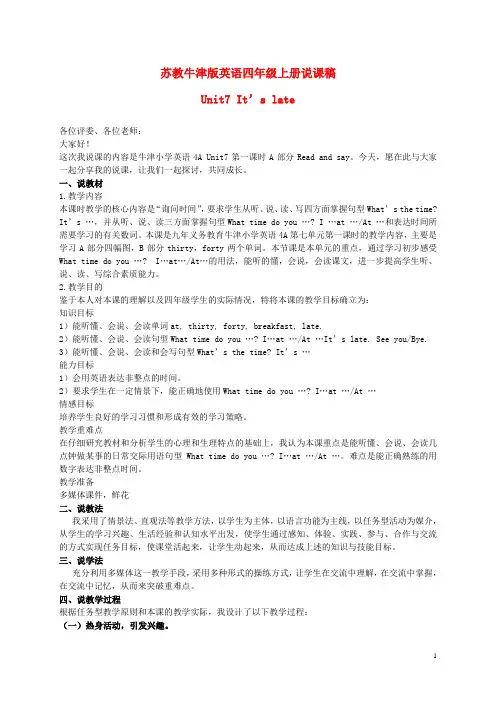
苏教牛津版英语四年级上册说课稿Unit7 It’s late各位评委、各位老师:大家好!这次我说课的内容是牛津小学英语4A Unit7第一课时A部分Read and say。
今天,愿在此与大家一起分享我的说课,让我们一起探讨,共同成长。
一、说教材1.教学内容本课时教学的核心内容是“询问时间”,要求学生从听、说、读、写四方面掌握句型What’s the time? It’s …,并从听、说、读三方面掌握句型What time do you …? I …at …/At …和表达时间所需要学习的有关数词。
本课是九年义务教育牛津小学英语4A第七单元第一课时的教学内容,主要是学习A部分四幅图,B部分thirty,forty两个单词。
本节课是本单元的重点,通过学习初步感受What time do you …? I…at…/At…的用法,能听的懂,会说,会读课文,进一步提高学生听、说、读、写综合素质能力。
2.教学目的鉴于本人对本课的理解以及四年级学生的实际情况,特将本课的教学目标确立为:知识目标1)能听懂、会说、会读单词at, thirty, forty, breakfast, late.2)能听懂、会说、会读句型What time do you …? I…at …/At …It’s late. See you/Bye. 3)能听懂、会说、会读和会写句型What’s the time? It’s …能力目标1)会用英语表达非整点的时间。
2)要求学生在一定情景下,能正确地使用What time do you …? I…at …/At …情感目标培养学生良好的学习习惯和形成有效的学习策略。
教学重难点在仔细研究教材和分析学生的心理和生理特点的基础上,我认为本课重点是能听懂、会说、会读几点钟做某事的日常交际用语句型What time do you …? I…at …/At …。
难点是能正确熟练的用数字表达非整点时间。
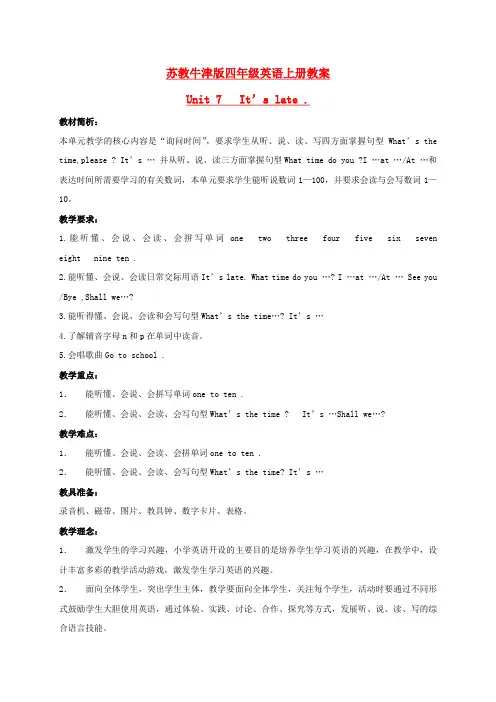
苏教牛津版四年级英语上册教案Unit 7 It’s late .教材简析:本单元教学的核心内容是“询问时间”,要求学生从听、说、读、写四方面掌握句型What’s the time,please ? It’s …并从听、说、读三方面掌握句型What time do you ?I …at …/At …和表达时间所需要学习的有关数词,本单元要求学生能听说数词1—100,并要求会读与会写数词1—10。
教学要求:1.能听懂、会说、会读、会拼写单词one two three four five six seven eight nine ten .2.能听懂、会说、会读日常交际用语It’s late. What time do you …? I …at …/At … See you /Bye ,Shall we…?3.能听得懂、会说、会读和会写句型What’s the time…? It’s …4.了解辅音字母n和p在单词中读音。
5.会唱歌曲Go to school .教学重点:1.能听懂、会说、会拼写单词one to ten .2.能听懂、会说、会读、会写句型What’s the time ? It’s …Shall we…?教学难点:1.能听懂、会说、会读、会拼单词one to ten .2.能听懂、会说、会读、会写句型What’s the time? It’s …教具准备:录音机、磁带、图片、教具钟、数字卡片、表格。
教学理念:1.激发学生的学习兴趣,小学英语开设的主要目的是培养学生学习英语的兴趣,在教学中,设计丰富多彩的教学活动游戏,激发学生学习英语的兴趣。
2.面向全体学生,突出学生主体,教学要面向全体学生,关注每个学生,活动时要通过不同形式鼓励学生大胆使用英语,通过体验、实践、讨论、合作、探究等方式,发展听、说、读、写的综合语言技能。
第一课时教学内容: A部分四幅图,B部分thirty ,forty两个单词。
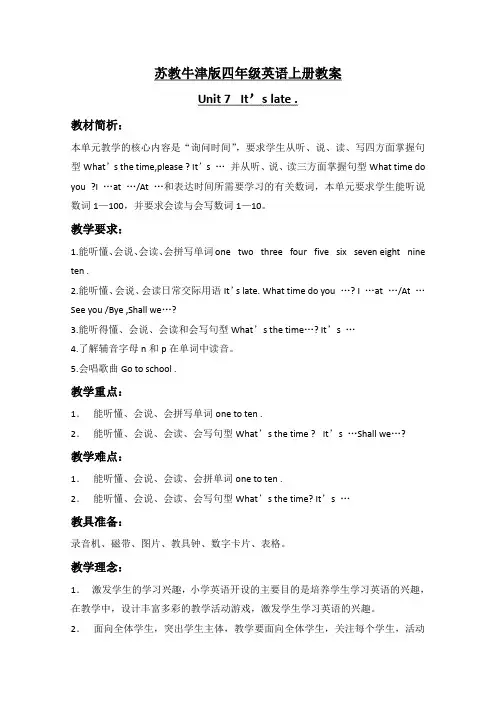
苏教牛津版四年级英语上册教案Unit 7 It’s late .教材简析:本单元教学的核心内容是“询问时间”,要求学生从听、说、读、写四方面掌握句型What’s the time,please ? It’s …并从听、说、读三方面掌握句型What time do you ?I …at …/At …和表达时间所需要学习的有关数词,本单元要求学生能听说数词1—100,并要求会读与会写数词1—10。
教学要求:1.能听懂、会说、会读、会拼写单词one two three four five six seven eight nine ten .2.能听懂、会说、会读日常交际用语It’s late. What time do you …? I …at …/At …See you /Bye ,Shall we…?3.能听得懂、会说、会读和会写句型What’s the time…? It’s …4.了解辅音字母n和p在单词中读音。
5.会唱歌曲Go to school .教学重点:1.能听懂、会说、会拼写单词one to ten .2.能听懂、会说、会读、会写句型What’s the time ? It’s …Shall we…?教学难点:1.能听懂、会说、会读、会拼单词one to ten .2.能听懂、会说、会读、会写句型What’s the time? It’s …教具准备:录音机、磁带、图片、教具钟、数字卡片、表格。
教学理念:1.激发学生的学习兴趣,小学英语开设的主要目的是培养学生学习英语的兴趣,在教学中,设计丰富多彩的教学活动游戏,激发学生学习英语的兴趣。
2.面向全体学生,突出学生主体,教学要面向全体学生,关注每个学生,活动时要通过不同形式鼓励学生大胆使用英语,通过体验、实践、讨论、合作、探究等方式,发展听、说、读、写的综合语言技能。
第一课时教学内容:A部分四幅图,B部分thirty ,forty两个单词。
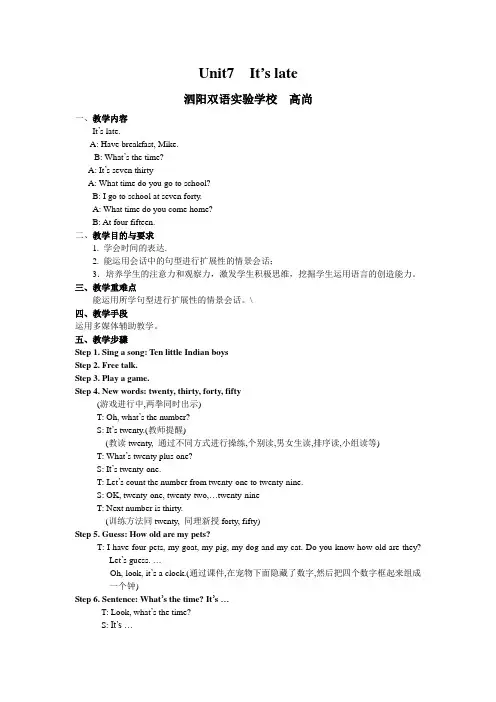
Unit7 It’s late泗阳双语实验学校高尚一、教学内容It’s late.A: Have breakfast, Mike.B: What’s the time?A: It’s seven thirtyA: What time do you go to school?B: I go to school at seven forty.A: What time do you come home?B: At four fifteen.二、教学目的与要求1. 学会时间的表达.2. 能运用会话中的句型进行扩展性的情景会话;3.培养学生的注意力和观察力,激发学生积极思维,挖掘学生运用语言的创造能力。
三、教学重难点能运用所学句型进行扩展性的情景会话。
\四、教学手段运用多媒体辅助教学。
五、教学步骤Step 1. Sing a song: Ten little Indian boysStep 2. Free talk.Step 3. Play a game.Step 4. New words: twenty, thirty, forty, fifty(游戏进行中,两拳同时出示)T: Oh, what’s the number?S: I t’s twenty.(教师提醒)(教读twenty, 通过不同方式进行操练,个别读,男女生读,排序读,小组读等)T: What’s twenty plus one?S: I t’s twenty-one.T: Let’s count the number from twenty-one to twenty-nine.S: OK, twenty-one, twenty-two,…twenty-nineT: Next number is thirty.(训练方法同twenty, 同理新授forty, fifty)Step 5. Guess: How old are my pets?T: I have four pets, my goat, my pig, my dog and my cat. Do you know how old are they?Let’s guess. …Oh, look, it’s a clock.(通过课件,在宠物下面隐藏了数字,然后把四个数字框起来组成一个钟)Step 6. Sentence: What’s the time? It’s …T: Look, what’s the time?S: It’s…(教学生先说小时后说分钟, 中间用短线连接. 不停地转动时针分针,让学生练习时间的说法)(时针转动到7点35分)T: What’s the time?S: It’s 7:35.Step 7. Phrases: have breakfast, go to school, come homeT: Oh, my little pig should have breakfast.(课件展示breakfast, have breakfast, 加以动作教读)T: Oh, it’s seven forty now. my little pig should go to school.(教读go to school)T: what’s the time?S: it’s four fifteen.T: my little pig should come home.Step 8. Sentence: What time do you … ? I … at …T: boys and girls, you did a good job.I have breakfast at 7:00 o’clock.What time do you have ?S: I have breakfast at ..Practice in pairs.Step 9. Play a game: Write and say.Some students write what he/she does. Some students write the time. Then ask two students to say a sentence.Step 10. Have a chant.go to school, go to school, what time do you go to school?Seven forty, seven forty, at seven forty.come home, come home, what time do you come home?four fifteen, four fifteen, at four fifteen.Step 11. Do a survey.1.Make a new dialogue in groups.六.板书设计Unit 7 I t’s lateWhat’s the time?It’s …What time do you …?I … at …have breakfast at go to school at come home at。
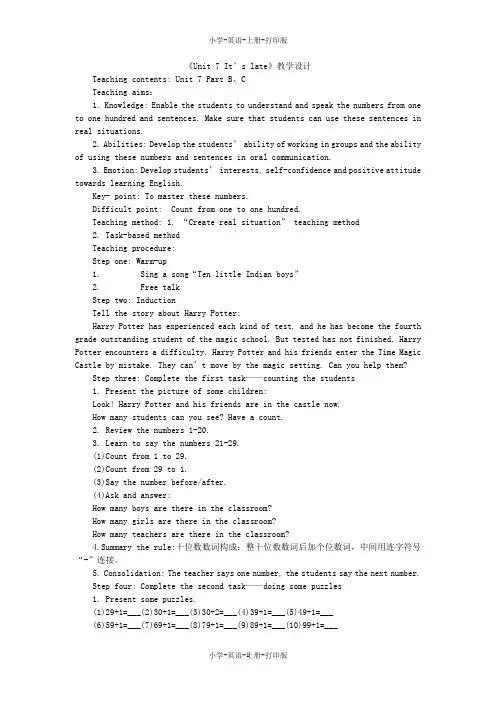
《Unit 7 It’s late》教学设计Teaching contents: Unit 7 Part B、CTeaching aims:1. Knowledge: Enable the students to understand and speak the numbers from one to one hundred and sentences. Make sure that students can use these sentences in real situations.2. Abi lities: Develop the students’ ability of working in groups and the ability of using these numbers and sentences in oral communication.3. Emotion: Develop students’ interests, self-confidence and positive attitude towards learning English.Key- point: To master these numbers.Difficult point: Count from one to one hundred.Teaching method: 1. “Create real situation” teaching method2. Task-based methodTeaching procedure:Step one: Warm-up1. Sing a song“Ten little Indian boys”2. Free talkStep two: InductionTell the story about Harry Potter:Harry Potter has experienced each kind of test, and he has become the fourth grade outstanding student of the magic school. But tested has not finished, Harry Potter encounters a difficulty. Harry Potter and his friends enter the Time Magic Castle by mistake. They can’t move by the magic setting. Can you help them?Step three: Complete the first task——counting the students1. Present the picture of some children:Look! Harry Potter and his friends are in the castle now.How many students can you see? Have a count.2. Review the numbers 1-20.3. Learn to say the numbers 21-29.(1)Count from 1 to 29.(2)Count from 29 to 1.(3)Say the number before/after.(4)Ask and answer:How many boys are there in the classroom?How many girls are there in the classroom?How many teachers are there in the classroom?4.Summary the rule:十位数数词构成:整十位数数词后加个位数词,中间用连字符号“-”连接。
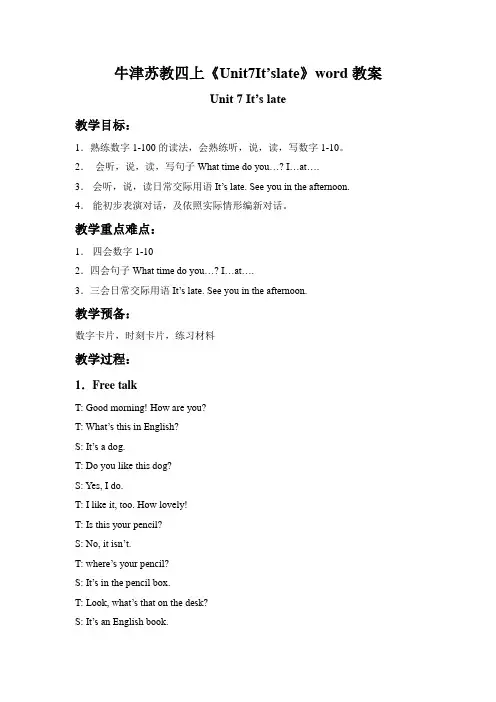
牛津苏教四上《Unit7It’slate》word教案Unit 7 It’s late教学目标:1.熟练数字1-100的读法,会熟练听,说,读,写数字1-10。
2.会听,说,读,写句子What time do you…? I…at….3.会听,说,读日常交际用语It’s late. See you in the afternoon.4.能初步表演对话,及依照实际情形编新对话。
教学重点难点:1.四会数字1-102.四会句子What time do you…? I…at….3.三会日常交际用语It’s late. See you in the afternoon.教学预备:数字卡片,时刻卡片,练习材料教学过程:1.Free talkT: Good morning! How are you?T: What’s this in English?S: It’s a dog.T: Do you like this dog?S: Yes, I do.T: I like it, too. How lovely!T: Is this your pencil?S: No, it isn’t.T: where’s your pencil?S: It’s in the pencil box.T: Look, what’s that on the desk?S: It’s an English book.T: Is that your English book?S: No, it isn’t.T: Whose English book is it?S: Perhaps it’s …’sT: Is it your English book?S: Yes, it is.T: Here you are.S: Thank you.T: Not at all.2.ReviewT: Today, we’ll continue Unit 7 It’s late.T: Boys and girls, can you do like this?(用手势打出1-10)Show me your hands. Follow me, please.T: We learned the numbers. Now ,I have some number cards. I hope you tell out the numbers quickly.(拿出数字卡片,用英语认读)3. 新授T: What’s this?S: It’s a clock.T: What’s the time please?S: It’s 6:00T: Yes, it is six. I get up at six every morning.What time do you get up?S: I get up at…(new word: at I get up at…)A: What time do you get up?B: I get up at…(work in pairs)同理教授have breakfast , have lunch用书上的D部分进行练习4. 读课文T: Now I want to introduce a friend to you. Who is he?S:MikeT: Who is she?S: GrandmaT: In the morning, Mike and grandma are talking about something. Listen to the tape ,try to answer the question.Q: What’s the time now?What time does Mike go to school?What time does Mike come home?听两遍录音后回答问题跟录音朗读课文分角色朗读课文5 .完成练习Choose the correct answersIt is 1 in the 2 now. Mike’s grandmothe r asks (叫) Mike to 3 . But it’s 4 . Mike goes to school at 5 . He comes home at 6 . He says ‘ 7 in the 8 ’ to his grandmother.( ) 1. A.7:00 B.7:35( ) 2. A.morning B.afternoon( ) 3. A.get up B.have breakfast( ) 4. A.early te( ) 5. A.7:40 B.7:30( ) 6.A.4:15 B.4:50( ) 7.A.See you B:Hello( ) 8.A.afternoon B.evening。
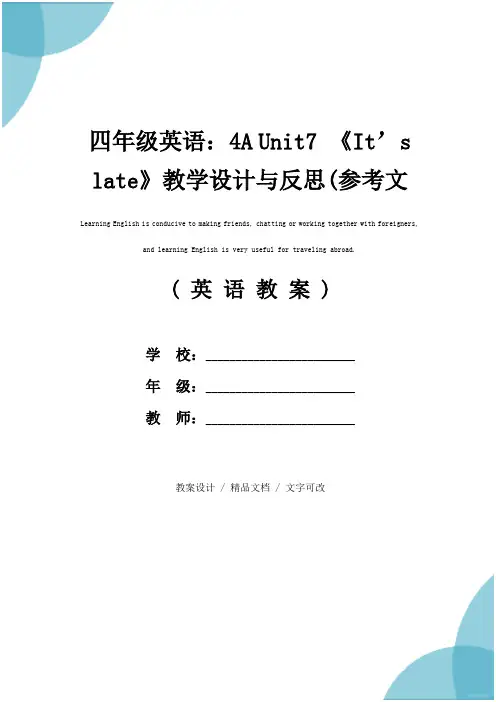
( 英语教案 )学校:_________________________年级:_________________________教师:_________________________教案设计 / 精品文档 / 文字可改四年级英语:4A Unit7 《It’s late》教学设计与反思(参考文Learning English is conducive to making friends, chatting or working together with foreigners, and learning English is very useful for traveling abroad.四年级英语:4A Unit7 《It’s late》教学设计与反思(参考文本)一、教学目标:1. 掌握数字1-10。
2. 掌握四会句型what’s the time, please? it’s3. 了解13-19,20-90的数字构成规律4. 听懂、会说句型it’s late. what time do you…? i…at…/at…5 通过游戏,比赛等多种形式,让学生在玩中学,学中玩。
二、教学重点,难点:1. 对时间和数字的表示2. what time do you …? i … at …?的正确使用。
三、教学过程a. freetalk.b. do some exercise.(复习以前所学的有关学习生活的词组)c. listen and count. (复习1——12的数字)d. do some maths exercises.(学习13——99的数字)e. read and say.(小组归纳1——99的数字拼写规律)f.play a game.(bomb game)g. ask and answer. (wolf, wolf, what’s the time? it’s…) look at the clock, ask and answer, make a new dialogue. t: hi, xxx.s: hi, miss late.t: what’s the time?s: it’s seven.t: it’s time to go to school!s: all right. but how?t: by bus.s: let’s go!h. learn: what time do you get up?at____.(出示钟面6点钟)say: i get up at six o’clock.drill: pass the football, ask and answer.i. learn: breakfast,what time do you have breakfast?i have breakfast at_____.(出示教师自己吃早饭的照片)ask and answer.j. learn: what time do you go to school? i go to school at ….(出示小丸子的上学图,让学生看图说话)k.chant: go, go, go.go to schoolwhat time do you go to school?i go to school at ____.(先练习教师提供的chant,然后进行替换练习,小组编chant,可以替换成go to tianmu lake, go to hongmei park, go to the cinema….) l.扩展练习(看图问答):姚明打篮球,同班同学踢足球,课文中的mike刷牙,文中的奶奶m.listen and say. (part a of unit 7)n. read after the tape.o. act the dialogue.p. do a survey. (part d of unit 7)q. talk about my daily life.4a unit 7 it’s late教学实录四甲中心小学张瑾step 1 greetingstep 2 free talk1.t: what"s this in english?s1: it"s a …t: is this your …?s1: no, it isn"t.t: whose … is this?s1: it"s xx"s.2.t: look at the rubbers. xx, are they your…?s2: no, they are not.t: whose … are they?s2: they"re xx"s.t: how many rubbers can you see?s2: let me see. one, two, three, …, ten. i can see ten rubbers.(课前跟学生借十块橡皮)step 3 presentation1. count the numbers from 1 to 10, then read and spell. (幻灯片出示数字一至十)2. count the numbers from 11 to 20. (幻灯片出示数字十一至二十)(1) t: can you count the numbersfrom 11 to 20?s3: yes, i can. 11,12, 13, …, 20.(2) read the numbers from 11 to 20(3)幻灯片出示数字13 至19, 找一找其构成规律。
小学牛津英语4A Unit7《It’s late》教案小学牛津英语4A Unit7《It’s late》教案(精选2篇)小学牛津英语4A Unit7《It’s late》教案篇1教学目标1、知识性目标:能听懂、会说、会读和会写句型 what time do you …?i …at….并能熟练运用。
2、过程性目标:学习方式:多媒体环境和网络环境下的自主学习和探究学习。
学习过程:a、在教师引导下探究——利用旧知探究新知,学习询问作息时间的表达法。
b、合作学习的过程:学生利用所学知识,创设不同场景,运用不同形式进行对话交流和小组合作。
c、个别探究的过程:回忆自己每天起床、上班、工作、用餐,就寝等时间,用所学句型加以描述。
d、思维碰撞的过程:全班交流、讨论学习成果、相互质疑与辨析。
3、情感性目标:a、用所学的询问作息时间的方法,关注生活中的英语,体验英语学习的快乐。
b、留心生活,运用英语,多说多练,形成学以致用的精神。
教学内容::小学牛津英语4a unit7 it’s late教学资源:围绕本课知识设计多种形式的练习情景,这些练习必须应用所学知识才能解决,又与学生先前的知识经验密切联系。
教学模式:多媒体环境下的合作性学习和探究性学习。
组织形式:旧知复习→全班交流、回忆→巩固练习→拓展练习→实际运用教学环境:正常班级授课,多媒体教室,教学课件教学重点:1能听懂、会说、会读和会写句型what time do you …?i …at….教学难点:1能正确理解、掌握课文会话,能运用所学知识创设场景编写对话。
教学准备:多媒体课件,跳绳,钟。
教学对象分析本班听说能力较好,场景表演也可以,有良好的预习复习的好习惯,学生之间相互合作学习的能力较强,能用英语进行交流。
教学媒体的选择与应用借助一定的媒体使学生能主动学习,积极探索,完成知识网络的建构。
1、解决问题:创设会话情景,通过会话让学生自主复习巩固所学的知识。
2、知识整理:正确掌握询问作息时间的表达方法、能合理应用所学知识。
苏教牛津版英语四年级上册《Its late》的教学设计这是一篇由网络搜集整理的关于苏教牛津版英语四年级上册《Its late》的教学设计的文档,希望对你能有帮助。
1、能听懂、会说、会读、会写句型What’s the time,please ? It’s …2、能运用句型What time do you …?了解同学一天的作息时间,完成信息交流的任务。
重点难点:1、了解辅音字母n和p在单词中读音2、能听懂、会说、会读、会写句型What’s the time? It’s …课前准备:录音机、磁带、图片、教具钟、数字卡片、表格教学过程:Step1 Warm up1、Greetings2、Sing a song 《This is the way 》3、Free talk围绕本单元句型交谈。
4、Say the number before .5、迅速记电话号码。
a.迅速说出自己家的.电话号码。
b.认读老师出示的号码。
Step 2 Review .师拿出教具钟,边拨边问:What’s the time,ple ase?Ss: It’s …先由师生对话,转向生生对话,如男女生之间,小组之间,排与排之间。
Step 3 C Ask and answer .1、出示挂图,生明确图意。
2、Practice in pairs .生口头操练。
3、指名到前面表达。
在学生回答完时间后,引导学生根据画面内容用It’s time to …的句型作补充回答,进行自编对话。
4、指导学生书写。
Step4 D Work in groups .1.Review .a.生听口令做动作。
get up have breakfast .go to school have lunch go home watch TV go to bed .b.认读这些动词词组。
2.填表,每小组发给一张表格。
a.师示范第一栏:T: What time do you get up /go to school …?S: I get up /go to school …at …b.小组内完成。
苏教牛津版四年级英语上册教案Unit7 It's late一、Warming up1.Let’s do it. get up, go to school, have lunch等2.Play a game.两名同学单脚独立,闭上眼睛,其余同学数数,复习1-20。
I’ll ask two students to come here. Stand like me. Close your eyes. Let’s count from one to twenty.二、Presentation1.猜谜语引出钟。
问:What’s the time?生答: It’s one o’clock.继续拨动钟面,问:What’s the time?生答: It’s ten twenty.引出30-90,教学新单词。
和13-19做比较。
2.Play a game.(高低音游戏)3.做加法介绍数字几十几的写法,提醒中间要加连字符。
4.拿出钟,拨到八点,问: What’s the time?生答:It’s eight.师:做焦急状,Oh,it’s too late. I go to school now. See you.教学I’m late. You’re late. Don’t be late.5.Chant6.出示时间转盘,问:What’s the time? 生:It’s seven forty-five. 师:It’s time to go to school.I go to school at seven forty-five. 板书,领读。
问:What time do you go to school?生答。
出示词组转盘,教学have breakfast师转动转盘,生小组问答,操练句型。
同桌上前转,互相问答句型。
同理操练由其它词组组成的句型。
三、Do excises.四、送给学生一句话Time has wings.教育学生应该珍惜时间。
Unit 7 It’s late一、教材分析本单元的核心教学内容是“询问时间”,要让学生从听、说、读、写四方面掌握句型What’s the time, please ?It’s …并从听、说和读三方面掌握句型What time do you …?I …at … / At …表达时间所需要和学习的有关数词。
本单元要求学生能听说数词1-100,并要求会读写数词1-10 。
二、学情分析本单元要求学生从学习数字1-100到询问时间(What’s the time ? It’s …)和在具体的某个时间做些什么事情(What time do you …? I … at …/ At …)。
在三年级时学生已经学习了数词1-20和询问时间的句型,不过学习的时间都是整点。
而本单元将把他们上升到四会的层次,另外本单元将继续学习100(包括100)以内的其他数词,以及非整点时间的表达法,这对学生来说又是一个难点,在课堂上我将多运用游戏、做加减法来巩固数词。
本单元有一个三会要求的句型即在具体的时间里做什么事情,学生不能很好的掌握,特别是at+时间的朗读。
三、教学目标1.能听得懂、会说、会读和会拼写单词one, two, three, four, five, six, seven ,eight ,nine, ten, time , what , afternoon.2.能听得懂、会说和会读日常交际用语It’s late. What time do you …? I …at …/At…See you /Bye ,Shall we…?3.能听得懂、会说、会读和会写What’s the time? It’s …4.了解辅音字母n和p 在单词中的读音。
5.会唱歌曲Go to school .四、教学重点1.能听懂、会说、会读和会拼写单词one, two, three, four, five, six, seven ,eight ,nine, ten, time , what , afternoon.2.能听得懂、会说、会读和会写句型What’s the time? It’s …五、教学难点1.对单词达到四会one , two , three , four , five , six , seven , eight , nine , ten , time ,what , afternoon.2.能听懂、会说、会读和会写句型What’s the time? It’s …六、教具准备:录音、实物、图片及头饰。
七、课时安排:5课时教学流程修改第一课时教学目标1.能听懂、会说、会读、会拼写单词1-10个数词还有time 和 what .2.能听懂、会说、会读和会写句型What’s the time? It’s …3.能听懂、会说和会读日常交际用语Have breakfast .教学重点1.能听懂、会说、会读、会拼写单词1-10个数词还有time 和 what 。
2.能听懂、会说、会读11-202.能听懂、会说、会读和会写句型What’s the time? It’s …教学难点1.单词达到四会1-10个数词还有time 和 what .2.能听懂、会说、会读和会写句型What’s the time? It’s …3.breakfast 的读音问题。
教学准备1.教具准备:单词卡片(1-20)、词组句型卡片(What’s the time ?It’s …Have breakfast.)数字卡片和时间卡片2.板书准备:Unit 7 It’s late教学过程Step 1 Prepare for the class .1. Read the text of Unit 6.2. Read the four-skill words.Step 2 Revison1. Say a rhymeOne , two , three2. Review the words from 1 to 12.T: What’s this ?S: It’s one .T: Can you spell it ?S: OK. O-N-E, one .同理复习2-12。
3. Gamea. Say the number before.b. Say next the number.在游戏中复习13-19。
在有关的个位数词词尾加+teen,有三个单词比较特殊:13 thirteen , 15 fifteen , 18 eighteen.Step 3 Presentation1. Draw a clock .T: What’s this ?S: It’s a clock.T: What’s the time ,please ?Ss: It’s one o’clock.个别,同桌,小组朗读单词time, o’clock 并讲解o’clock 同音a clock2. 出示整点的时间,ask and answerA: What’s the time ,please ?B: It’s … o’clock.T-S, S-S , S- T3. 出示非整点时间T: Look ! What’s this?S: It’s 6.T: And what’s this ?S: It’s 10.T: Now what’s the time?S: It’s 6: 10个别,同桌,小组朗读six tenT: It’s time to get up .T: 另一时间 7: 10What’s the time ?S: It’s seven ten.T: It’s time to have breakfast .个别,同桌,小组朗读 have breakfast 4. Pair workA: What’s the time ?B: It’s …a. Practise with their partners 数字和时间的表达学生已经接触过,本单元老师可以再正点的基础上引出非整点的教学。
b. Choose some pairs to check.Step 4 Assign homework1.Copy the words .one , two , three, four , five , six, seven , eight ,nine ,ten ,eleven , twelve , thirteen , fourteen , fifteen , sixteen , seventeen , eighteen , nineteen , twenty ,time , what .2.Try to dictate the twelve words.<1-10, time , what>七、板书设计 Unit 71 one 11 eleven 6 six 16sixteen2 two 12 twelve 7 seven 17 seventeen3 three 13 thirteen 8 eight 18eighteen4 four 14 fourteen 9 nine 19nineteen5 five 15fifteen 10 ten 20twentyA: What’s the time ? 整点(可以两种)B: It’s one o’clock或者 one (1:00)非整点 1:10 oneten八、教后小记教学流程修改第二课时教学目标1.能听懂、会说、会读、会拼写单词afternoon.2.能听懂、会说和会读单词thirty , forty , fifty , sixty ,seventy , eighty , ninety , a hundred .3.能听懂、会说和会读其他的两位数。
教学重点1.能听懂、会说、会读、会拼写单词afternoon.2.能听懂、会说和会读单词thirty , forty , fifty , sixty , seventy , eighty , ninety , a hundred .3.能听懂、会说和会读其他的两位数。
教学难点1.能听懂、会说和会读单词thirty , forty , fifty , sixty , seventy , eighty , ninety , a hundred .2.能听懂、会说和会读其他的两位数。
教学准备1.教具准备:数字卡片、加减法算式、磁带、录音。
2.板书准备:Unit 7教学过程Step 1 Prepare for class1.Ss read and spell the words from 1 to 20.2.Say a rhyme <one , two , three>3.Greetings:T: Good afternoon , boys and girls.S: Good afternoon , Miss Xu .T: 出示单词卡朗读单词:afternoon.分解教after +noonStep 2 Revision “1到20之间”1.Say the number before.2.Say the next number.3.Say the numbers from the card the teacher gives .Step 3 Presentation1.T: What’s the number ?S: It’s two .T: What’s the number ?S: It’s eleven .T: Now what’s two plus eleven ?S: It’s thirteen .2.根据加减法算式,进行问答。
A: What’s … plus / minus …?B: It’s …6+9 6+10 3+6 4+8 4+11 8+9 5+13 4+14 11+8 2+11 学生对于thirteen fifteeen 及19- 17 20-6 13-11 18-2 14-3 17-6 16-10 15-9 11-8 10- 63.Say the numbers one by one from 1 to 20T: The next number is twenty - …S: Twenty ?one .T: 21, 22 , 23 , 24, 25, 26 , 27 , 28 , 29 , 30.出示单词thirty , forty , for 与four 是同音词以此类推为…Ss 根据单词卡朗读单词Fifty , sixty , seventy , eighty , ninety4.总结整十位数的规律:在有关的个位数的词尾加+y。
有一个单词比较特别 forty.。